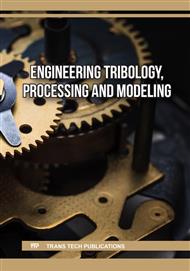p.17
p.23
p.33
p.41
p.47
p.55
p.63
p.71
p.79
Wear of the 3D Printed Polylactic Acid Elements Sliding against the Synthetic Resins at the Higher Speed Friction
Abstract:
Since the requirement of high dust-free levels, it is necessary to develop the technologies with anti-wear and low dust generation for drive elements that can be quickly printed. Polylactic acid and synthetic resins are often paired with each other for the 3D printed driven elements. To achieve "smooth friction", the adhesion wear under dry friction conditions should be reduced. To achieve a "high dust-free level", the anti-wear of the paired elements under higher speed friction should be improved to reduce the generation of abrasive dust. Therefore, wear of the 3D printed polylactic acid elements sliding against the synthetic resins at the high speed friction are investigated in this paper.
Info:
Periodical:
Pages:
47-54
Citation:
Online since:
January 2024
Authors:
Keywords:
Price:
Сopyright:
© 2024 Trans Tech Publications Ltd. All Rights Reserved
Share:
Citation:


